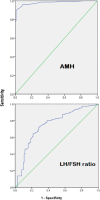Assessment of the Role of the Anti-Mullerian Hormone, Luteinizing Hormone/Follicle Stimulating Hormone Ratio in the Diagnosis of Polycystic Ovary Syndrome in Sudanese Women
- PMID: 30087729
- PMCID: PMC6062285
- DOI: 10.3889/oamjms.2018.260
Assessment of the Role of the Anti-Mullerian Hormone, Luteinizing Hormone/Follicle Stimulating Hormone Ratio in the Diagnosis of Polycystic Ovary Syndrome in Sudanese Women
Abstract
Background: The diagnosis of polycystic ovary syndrome (PCOS) is not an easy procedure, as the signs and symptoms are heterogeneous and of undefined aetiology.
Aim: This study is aimed to evaluate serum anti-Mullerian hormone (AMH) level and luteinizing hormone (LH)/folic stimulating hormone (FSH) ratio in women with PCOS in Sudan and to assess the diagnostic efficiency for the diagnosis of PCOS.
Methods: In a case-control study, Serum AMH, LH, FSH was measured in the early follicular phase from Sudanese patients (N = 230) with PCOS and100 controls. The LH/FSH ratio was calculated, and its diagnostic power was evaluated by receiver operating characteristic curves.
Results: The means of serum AMH, serum LH level and LH/FSH ratio of the test, were significantly increased in the test group compared to the control group (P-value < 0.000). The AMH sensitivity, specificity, Positive Predictive Value (PPV) and Negative Predictive Value (NPV) were found to be 83%, 99%, 99%, and 72% respectively. Serum AMH was considered adequate measures for the diagnosis of PCOS; its level showed an area under the ROC curve of 0.98 (95% confidence, P-value < 0.000). The best compromise between 98% specificity and 90% sensitivity was obtained with a cut-off value of 3.3 ng/mL for PCOS diagnosis. There was no correlation between age, body mass index (BMI) and AMH level in the test group.
Conclusions: The Serum AMH level and LH/FSH ratio were higher in patients than in control. However AMH level has better discriminative power and good diagnostic potency for the diagnosis of the PCOS among Sudanese women.
Keywords: Anti-Müllerian hormone; Follicle Stimulating Hormone; Luteinizing Hormone; Ovulation; Polycystic Ovary Syndrome; Sudanese women.
Figures
Similar articles
-
Diagnostic Performance of Anti-Müllerian Hormone, Luteinizing Hormone to Follicle-Stimulating Hormone Ratio, Testosterone, and Prolactin to Predict Polycystic Ovary Syndrome Among Sudanese Women.Int J Womens Health. 2023 May 29;15:837-843. doi: 10.2147/IJWH.S403347. eCollection 2023. Int J Womens Health. 2023. PMID: 37275514 Free PMC article.
-
Elevated serum levels of anti-Müllerian hormone can be introduced as a new diagnostic marker for polycystic ovary syndrome.Acta Obstet Gynecol Scand. 2013 Dec;92(12):1369-74. doi: 10.1111/aogs.12247. Epub 2013 Oct 15. Acta Obstet Gynecol Scand. 2013. PMID: 23980726
-
Threshold value of anti-Mullerian hormone for the diagnosis of polycystic ovary syndrome in Chinese women.PLoS One. 2018 Aug 28;13(8):e0203129. doi: 10.1371/journal.pone.0203129. eCollection 2018. PLoS One. 2018. PMID: 30153296 Free PMC article.
-
The role of anti-Müllerian hormone in the pathogenesis and pathophysiological characteristics of polycystic ovary syndrome.Eur J Obstet Gynecol Reprod Biol. 2016 Apr;199:82-7. doi: 10.1016/j.ejogrb.2016.01.029. Epub 2016 Feb 10. Eur J Obstet Gynecol Reprod Biol. 2016. PMID: 26914398 Review.
-
Interactions between androgens, FSH, anti-Müllerian hormone and estradiol during folliculogenesis in the human normal and polycystic ovary.Hum Reprod Update. 2016 Nov;22(6):709-724. doi: 10.1093/humupd/dmw027. Epub 2016 Aug 27. Hum Reprod Update. 2016. PMID: 27566840 Review.
Cited by
-
Diagnostic Performance of Anti-Müllerian Hormone, Luteinizing Hormone to Follicle-Stimulating Hormone Ratio, Testosterone, and Prolactin to Predict Polycystic Ovary Syndrome Among Sudanese Women.Int J Womens Health. 2023 May 29;15:837-843. doi: 10.2147/IJWH.S403347. eCollection 2023. Int J Womens Health. 2023. PMID: 37275514 Free PMC article.
-
Elevated Anti-Müllerian Hormone as a Prognostic Factor for Poor Outcomes of In Vitro Fertilization in Women with Polycystic Ovary Syndrome.Biomedicines. 2023 Nov 27;11(12):3150. doi: 10.3390/biomedicines11123150. Biomedicines. 2023. PMID: 38137371 Free PMC article.
-
Age-specific cut-off levels of anti-Müllerian hormone can be used as diagnostic markers for polycystic ovary syndrome.Reprod Biol Endocrinol. 2021 May 22;19(1):76. doi: 10.1186/s12958-021-00755-8. Reprod Biol Endocrinol. 2021. PMID: 34022904 Free PMC article.
-
Predictors of Pregnancy after Artificial Insemination in Women with Polycystic Ovary Syndrome.JBRA Assist Reprod. 2025 Jul 30;29(2):201-210. doi: 10.5935/1518-0557.20240095. JBRA Assist Reprod. 2025. PMID: 39983029 Free PMC article.
-
Analysis of Endocrine and Metabolic Indexes in Non-Obese Patients with Polycystic Ovary Syndrome and Its Compare with Obese Patients.Diabetes Metab Syndr Obes. 2021 Oct 15;14:4275-4281. doi: 10.2147/DMSO.S329108. eCollection 2021. Diabetes Metab Syndr Obes. 2021. PMID: 34703260 Free PMC article.
References
-
- Goodarzi MO, Dumesic DA, Chazenbalk G, Azziz R. Polycystic ovary syndrome: aetiology, pathogenesis and diagnosis. Nat Rev Endocrinol. 2011;7(4):219–231. https://doi.org/10.1038/nrendo.2010.217 PMid:21263450. - PubMed
-
- Durlinger AL, Gruijters MJ. (2001); Anti-Mullerian hormone attenuates the effects of FSH on follicle development in the mouse ovary. Endocrinology. 2001;142:4891–4899. https://doi.org/10.1210/endo.142.11.8486 PMid:11606457. - PubMed
-
- Rotterdam ESHRE/ASRM-Sponsored PCOS Consensus Workshop Group. Revised 2003 consensus on diagnostic criteria and long-term health risks related to polycystic ovary syndrome. Fertil Steril. 2004;81:19–25. https://doi.org/10.1016/j.fertnstert.2003.10.004. - PubMed
-
- Hoeger KM. Role of lifestyle modification in the management of polycystic ovary syndrome. Best Pract Res Clin Endocrinol Metab. 2006;20:293–310. https://doi.org/10.1016/j.beem.2006.03.008 PMid:16772159. - PubMed
-
- Bungum L, Franssohn F, Bungum M, Humaidan P, Giwercman A. The Circadian Variation in Anti-Müllerian Hormone in Patients with Polycystic Ovary Syndrome Differs Significantly from Normally Ovulating Women. PLoS ONE. 2013;8(9):e68223. https://doi.org/10.1371/journal.pone.0068223 PMid:24023708 PMCid: PMC3762839. - PMC - PubMed
LinkOut - more resources
Full Text Sources
Other Literature Sources



